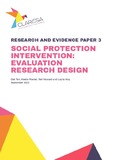| dc.contributor.author | Ton, Giel | |
| dc.contributor.author | Roelen, Keetie | |
| dc.contributor.author | Howard, Neil | |
| dc.contributor.author | Huq, Lopita | |
| dc.date.accessioned | 2022-09-13T10:19:36Z | |
| dc.date.available | 2022-09-13T10:19:36Z | |
| dc.date.issued | 2022-09-13 | |
| dc.identifier.citation | Ton, G.; Roelen, K.; Howard, N. and Huq, L. (2022) Social Protection Intervention: Evaluation Research Design, CLARISSA Research and Evidence Paper 3, Brighton: Institute of Development Studies, DOI: 10.19088/CLARISSA.2022.004 | en |
| dc.identifier.uri | https://opendocs.ids.ac.uk/opendocs/handle/20.500.12413/17632 | |
| dc.description.abstract | This paper describes the research design for investigating and evaluating the Child Labour: Action-Research-Innovation in South and South-Eastern Asia (CLARISSA) social protection cash-plus intervention in a slum in Dhaka, Bangladesh. After an introductory section, the second section elaborates on contribution analysis – the methodological approach underpinning the research design. The third section provides an overview of the intervention, and the fourth explores the overall design of the evaluation, its guiding framework, and the timeline of the intervention rollout and data collection. The fifth and sixth sections address the project’s suite of quantitative and qualitative methods, and the approach to data analysis. Using four panel surveys, bi-monthly monitoring, in-depth interviews, group discussions and direct observations, the research will zoom in on specific behaviours. First, at the individual level, we want to learn how people adopt alternative livelihoods in response to the intervention. Second, at the household level, we consider how community mobilisation and cash transfers help households to resolve intra‑household problems. Third, at the group level, we consider how groups manage collective action in response to community mobilisation. For each of these behaviour change outcomes, we want to understand the realist evaluation question, ‘Why does the intervention work, for whom, and under what conditions?’ We also want to assess whether these new behaviours change the propensity for children to be involved in the worst forms of child labour. | en |
| dc.language.iso | en | en |
| dc.publisher | Institute of Development Studies | en |
| dc.relation.ispartofseries | CLARISSA Research and Evidence Paper;3 | |
| dc.rights.uri | http://creativecommons.org/licenses/by/4.0/ | en |
| dc.title | Social Protection Intervention: Evaluation Research Design | en |
| dc.rights.holder | © Institute of Development Studies 2022 | en |
| dc.identifier.doi | 10.19088/CLARISSA.2022.004 | |
| rioxxterms.funder | Default funder | en |
| rioxxterms.identifier.project | CLARISSA | en |
| rioxxterms.version | VoR | en |
| rioxxterms.versionofrecord | 10.19088/CLARISSA.2022.004 | en |
| rioxxterms.funder.project | e37f47ed-efba-4cc9-b41f-97dc8647b483 | en |


